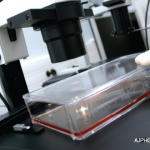Metabolites could help predict survival rates after a severe burn, and “if you could work out which metabolic pathways are involved, you may be able to intervene and change them to improve survival,” he said.
What about chronic inflammation? In diseases like RA or uveitis, metabolic changes tell us a great deal, too. Macrophage activation may determine the metabolic profiles in the blood in inflammatory disease, he said. Other cells contribute too, since synovial fibroblasts in RA joints show a different metabolic profile than normal controls.
“RA cells produce high levels of lactate, which suggests they are switching on glycolysis,” said Dr. Young. This process is not affected by oxygen levels, he added. “Fibroblasts isolated from a hypoxic environment retain an inflammatory and glycolytic metabotype in vitro,” and this is related to raised CRP levels in those patients.
Metabolic fingerprinting has already revealed important clues about disease course and treatment responses, Dr. Young said.3
With more research in this area, “there may be some predictive value of metabolites in early RA, telling us who will go on to chronic disease and who will have self-limiting disease, and it could also predict different responses to different drugs.”
Susan Bernstein is a freelance medical journalist based in Atlanta.
References
- Wofford JA, Wieman HL, Jacobs SR, et al. IL-7 promotes GLUT1 trafficking and glucose uptake via STAT5-mediated activation of Akt to support T-cell survival. Blood. 2008 Feb 15;111(4): 2101–2111. Epub ahead of print.
- Biniecka M, Kennedy A, Ng CT, et al. Successful tumor necrosis factor (TNF) blocking therapy suppresses oxidative stress and hypoxia-induced mitochondrial mutagenesis in inflammatory arthritis. Arthritis Res Ther. 2011 Jul 25;13(4):R121.
- Young SP, Kapoor SR, Viant MR, et al. The impact of inflammation on metabolomics profiles in patients with arthritis. Arthritis Rheum. 2013 Aug;65(8):2015–2023.


